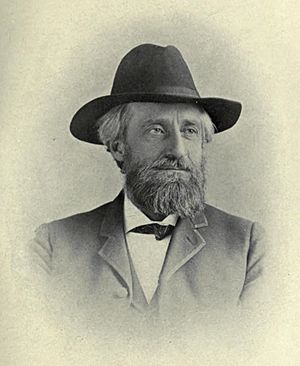Nathaniel Shaler facts for kids
Quick facts for kids
Nathaniel Southgate Shaler
|
|
|---|---|

Nathaniel Shaler in 1894.
|
|
| Born | February 20, 1841 |
| Died | April 10, 1906 (aged 65) |
| Nationality | American |
| Alma mater | Harvard College |
| Scientific career | |
| Fields | Paleontology, Geology |
| Institutions | Lawrence Scientific School |
| Doctoral advisor | Louis Agassiz |
| Doctoral students | Charles Henry Smyth, Jr. Edward A. Birge |
| Other notable students | Ralph Stockman Tarr |
| Author abbrev. (zoology) | Shaler |
| Signature | |
 |
|
Nathaniel Southgate Shaler (born February 20, 1841 – died April 10, 1906) was an American scientist. He was a paleontologist, who studies fossils, and a geologist, who studies Earth's rocks and landforms. Shaler wrote many books and articles about science and the idea of evolution. However, some of his ideas about human races are now seen as harmful and wrong. This is known as Scientific racism.
Contents
His Life and Career
Nathaniel Shaler was born in Kentucky in 1841. His family owned enslaved people. He went to Harvard College and studied at its Lawrence Scientific School. His teacher was a famous scientist named Louis Agassiz.
After finishing college in 1862, Shaler stayed at Harvard. He became a lecturer in 1868. Then, he was a professor of paleontology from 1869 to 1888. After that, he taught geology until 1906. In 1891, he became the dean of the Lawrence School.
Shaler also worked for the government. From 1873 to 1880, he was the director of the Kentucky Geological Survey. In 1884, he joined the U.S. Geological Survey. He was in charge of the Atlantic region. He also served as a commissioner of agriculture for Massachusetts. In 1895, he was the president of the Geological Society of America. During the American Civil War, he was an officer for the Union army.
His Research and Views
When Shaler first started his career, he believed in Creationism. This is the idea that life was created by a divine being. He did not agree with Charles Darwin's theory of evolution. This was partly because his teacher, Louis Agassiz, also held these views.
Later, Shaler slowly began to accept Darwin's ideas about evolution. However, he saw evolution through a different lens called Lamarckian ideas. This view suggests that living things can pass on traits they gain during their lives.
Shaler studied how animals like earthworms and ants help create soil. He expanded on Darwin's work about how earthworms change the soil. Like many scientists of his time, Shaler tried to fit natural selection into a bigger picture. He believed that evolution showed order and purpose in nature.
Sadly, Shaler also held beliefs that supported slavery. He openly believed that the Anglo-Saxon race was superior to others. In his later career, he continued to support Agassiz's idea of polygenism. This theory said that different human races came from different origins. This idea was often used to support racial discrimination.
In 1884, Shaler wrote an article called "The Negro Problem." It was published in the Atlantic Monthly magazine. In this article, he made harmful claims about Black people who had been freed from slavery. He said they needed "protection" and that slavery in America was "the mildest" system ever. He also wrote that the geography of different continents affected the intelligence of the people living there. He wrongly claimed that the "Aryan race" was superior because of where they developed in Europe.
Shaler believed that slavery was good for the United States. He even suggested that enslaved people benefited from it. He thought it helped them "control their own destiny." He worried that the South would "release into barbarism" without slavery. He believed that Black people needed to stay close to the "superior race" to develop. These views are now widely recognized as deeply flawed and harmful.
His Impact at Harvard
Later in his career, Shaler was the Dean of Sciences at Harvard. He was known as one of the university's most popular teachers. He wrote many books and articles on various topics. These included land surveys and ideas about right and wrong.
Shaler guided many students, including William Morris Davis. Davis worked as Shaler's assistant and later taught at Harvard. Davis became a famous geographer. Like Shaler, he also wrote about how different places might lead to more or less successful societies.
After Shaler passed away, a special fund was created in his honor. This fund helps students go on field trips today. Shaler also convinced a wealthy businessman named Gordon McKay to leave most of his money to Harvard. This money helped expand Harvard's science programs.
His Books
Shaler wrote many books and articles during his life. Here are some of them:
- (1870). On the Phosphate Beds of South Carolina.
- (1876–82). Geological Survey of Kentucky [6 volumes].
- (1878). Thoughts on the Nature of Intellectual Property and its Importance to the State.
- (1881). Illustrations of the Earth's Surface; Glaciers [with William Morris Davis].
- (1884). A First Book in Geology.
- (1885). Kentucky, a Pioneer Commonwealth.
- (1891). Nature and Man in America.
- (1892). The Story of Our Continent.
- (1893). The Interpretation of Nature.
- (1895). Domesticated Animals.
- (1896). American Highways.
- (1898). Outlines of the Earth's History.
- (1900). The Individual: Study of Life and Death.
- (1904). The Citizen: A Study of the Individual and the Government.
- (1905). Man and the Earth.
- (1909). The Autobiography of Nathaniel Southgate Shaler.
He also wrote some fiction and poetry:
- (1903). Elizabeth of England: A Dramatic Romance in Five Parts.
- (1906). From Old Fields: Poems of the Civil War.
See also
 In Spanish: Nathaniel Shaler para niños
In Spanish: Nathaniel Shaler para niños
- Bully for Brontosaurus
Images for kids

